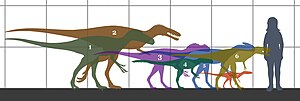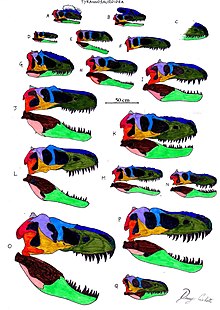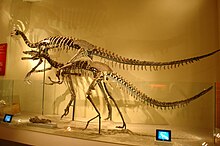
Dilong is a genus of basal tyrannosauroid dinosaur. The only species in this genus is Dilong paradoxus. It is from the Lower Cretaceous Yixian Formation near Lujiatun, Beipiao, in the western Liaoning province of China. It lived about 126 million years ago. This theropod discovery was significant as it was one of the first tyrannosauroids with fossil evidence of simple feathers.
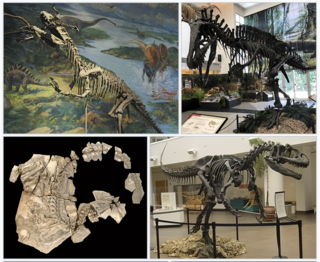
Carnosauria is an extinct group of carnivorous theropod dinosaurs that lived during the Jurassic and Cretaceous periods.

Neovenator is a genus of carcharodontosaurian theropod dinosaur. It is known from several skeletons found in the Early Cretaceous (Hauterivian-Barremian) Wessex Formation on the south coast of the Isle of Wight, southern England. It is one of the best known theropod dinosaurs from the Early Cretaceous of Europe.

Appalachiosaurus is a genus of tyrannosaurian theropod dinosaur from the Late Cretaceous period of what is now eastern North America. It was a basal member of the Eutyrannosauria clade meaning it was rather close in relation to the true tyrannosaurids such as Tyrannosaurus. Like most theropods, it was a bipedal predator. Only a juvenile skeleton has been found, representing an animal approximately 6.5 metres (21 ft) long and weighing 623 kilograms (1,373 lb), which indicates an adult would have been significantly larger.
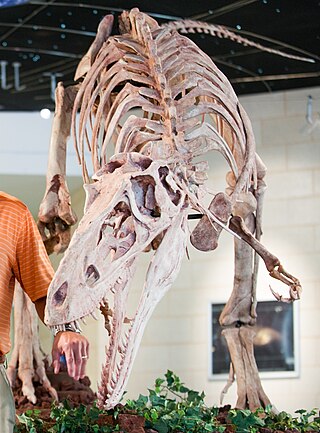
Alioramus is a genus of tyrannosaurid theropod dinosaurs from the Late Cretaceous period of Asia. It currently contains two species. The type species, A. remotus is known from a partial skull and three foot bones recovered from the Mongolian Nemegt Formation, which was deposited in a humid floodplain about 70 million years ago. These remains were named and described by Soviet paleontologist Sergei Kurzanov in 1976. A second species, A. altai, known from a much more complete skeleton also from the Nemegt Formation, was named and described by Stephen L. Brusatte and colleagues in 2009. Its relationships to other tyrannosaurid genera were at first unclear, with some evidence supporting a hypothesis that Alioramus was closely related to the contemporary species Tarbosaurus bataar. However, the discovery of Qianzhousaurus indicates that it belongs to a distinct branch of tyrannosaurs, namely the tribe Alioramini.
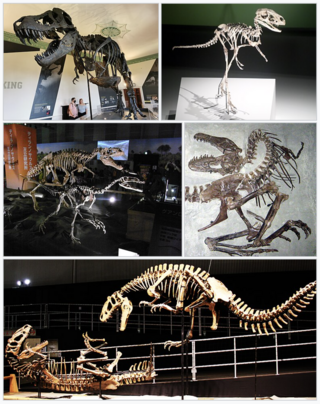
Tyrannosauroidea is a superfamily of coelurosaurian theropod dinosaurs that includes the family Tyrannosauridae as well as more basal relatives. Tyrannosauroids lived on the Laurasian supercontinent beginning in the Jurassic Period. By the end of the Cretaceous Period, tyrannosauroids were the dominant large predators in the Northern Hemisphere, culminating in the gigantic Tyrannosaurus. Fossils of tyrannosauroids have been recovered on what are now the continents of North America, Europe and Asia, with fragmentary remains possibly attributable to tyrannosaurs also known from South America and Australia.
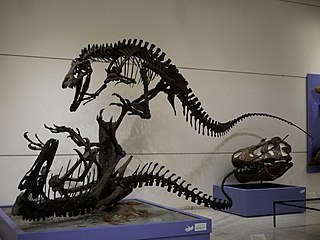
Dryptosaurus is a genus of basal eutyrannosaurian theropod dinosaur that lived on the island continent of Appalachia approximately 67 million years ago during the end of the Maastrichtian age of the Late Cretaceous period. Dryptosaurus was a large, bipedal, ground-dwelling carnivore that could grow up to 7.5 metres (25 ft) long and weigh up to 756–1,500 kilograms (1,667–3,307 lb). Although it is now largely unknown outside of academic circles, the famous 1897 painting of the genus by Charles R. Knight made Dryptosaurus one of the more widely known dinosaurs of its time, in spite of its poor fossil record. First described by Edward Drinker Cope in 1866 and later renamed by Othniel Charles Marsh in 1877, Dryptosaurus is among the first theropod dinosaurs ever known to science.

Suzhousaurus is a genus of large therizinosauroid dinosaur from the Early Cretaceous of China. The genus is known from two specimens discovered on the Xiagou Formation and Zhonggou Formation—which are situated in the Xinminbao Group. These findings were made during field-works in 1999 and 2004. Though Suzhousaurus is known from these two specimens, an earlier named and described therizinosauroid from the adjacent basin, "Nanshiungosaurus" bohlini, may be synonymous with the former. However, Suzhousaurus can not be compared to this species due to non-overlapping material and the loss of the same. Moreover, this synonymy will result in Suzhousaurus bohlini with "N". bohlini having priority.

Beishanlong is a genus of giant ornithomimosaurian theropod dinosaur from the Early Cretaceous of China. It is the second-largest ornithomimosaur discovered, only surpassed by Deinocheirus.

Sinotyrannus was a early, large-bodied genus within the superfamily Tyrannosauroidea. This dinosaur had a single type species, S. kazuoensis, with the only known specimen containing a partial skull, some vertebrae, and a hip, all of which were found in the Early Cretaceous aged Jiufotang Formation of Liaoning, China. While it exhibited greater body size that would put it on par with the later tyrannosaurids such as Tyrannosaurus, Sinotyrannus was probably a member of the basal tyrannosaur family known as the Proceratosauridae. This family originated in the Jurassic, whose members are known from Europe and Asia. Sinotyrannus, alongside another early tyrannosaur, Yutyrannus, appears to have been oddly large when compared to most tyrannosaurs of the Early Cretaceous, such as Dilong. Most of the world during the Early Cretaceous was dominated by more basal tetanurans, such as the megalosaurs and allosaurs, with tyrannosaurids themselves only taking over after both groups started to decline. However, Sinotyrannus and Yutyrannus appear to be exceptions to this. Sinotyrannus was the largest theropod in the Jiufotang Formation, reaching up to 10 meters in overall length and having a general mass similar to that of a large rhino.

Megaraptora is a clade of carnivorous theropod dinosaurs with controversial relationships to other tetanuran theropods. Its derived members, the Megaraptoridae are noted for their large hand claws and powerfully-built forelimbs, which are usually reduced in size in other large theropods.

Proceratosauridae is a family or clade of tyrannosauroid theropod dinosaurs from the Middle Jurassic to the Early Cretaceous.
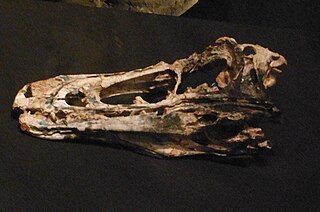
Haplocheirus is an extinct genus of theropod dinosaur from the Middle Jurassic Shishugou Formation of Xinjiang in China. It is generally considered to be an alvarezsauroid, although some researchers have questioned this assignment. The genus contains a single species, H. sollers, which is known from a mostly complete skeleton including the skull.

Qiupalong is an extinct genus of ornithomimosaurian theropod that was discovered in the Late Cretaceous Qiupa Formation of Henan, China. The genus contains a single species, Q. henanensis, the specific epithet for which was named for the province of Henan. Uniquely, Qiupalong is one of the few Late Cretaceous non-avian dinosaurs known from both Asia and Laramidia. Specimens from Russia and Alberta have been referred to the genus without being assigned to the type species.
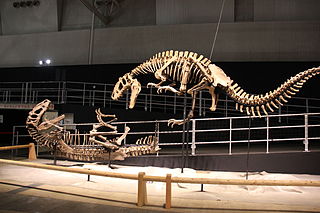
Yutyrannus is a genus of proceratosaurid tyrannosauroid dinosaur which contains a single known species, Yutyrannus huali. This species lived during the early Cretaceous period in what is now northeastern China. Three fossils of Yutyrannus huali —all found in the rock beds of Liaoning Province— are currently the largest-known dinosaur specimens that preserve direct evidence of feathers.
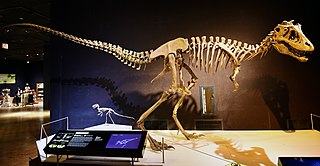
Lythronax is a genus of tyrannosaurid dinosaur that lived in North America around 81.9-81.5 million years ago during the Late Cretaceous period. The only known specimen was discovered in Utah in the Wahweap Formation of the Grand Staircase–Escalante National Monument in 2009, and it consists of a partial skull and skeleton. In 2013, it became the basis of the new genus and species Lythronax argestes; the generic name Lythronax means "gore king", and the specific name argestes originates from the Greek poet Homer's name for the wind from the southwest, in reference to the specimen's geographic provenance in North America.

Siats (/see-ats/) is an extinct genus of large theropod dinosaur known from the Late Cretaceous Cedar Mountain Formation of Utah, United States. It contains a single species, Siats meekerorum. It was initially classified as a megaraptoran, a clade of large theropods with very controversial relationships. Siats may be a neovenatorid allosauroid, a coelurosaur of uncertain phylogenetic position, or a tyrannosauroid.

Alioramini is a tribe of long-snouted tyrannosaurine tyrannosaurids from the Late Cretaceous epoch. It includes the tyrannosaurid genera Alioramus and Qianzhousaurus. Although tyrannosaurids are known from a variety of places around the globe, alioramins are currently restricted to Asia in mostly Maastrichtian strata. Many of the fossils attributed to Alioramini are not from fully developed individuals.

This timeline of tyrannosaur research is a chronological listing of events in the history of paleontology focused on the tyrannosaurs, a group of predatory theropod dinosaurs that began as small, long-armed bird-like creatures with elaborate cranial ornamentation but achieved apex predator status during the Late Cretaceous as their arms shrank and body size expanded. Although formally trained scientists did not begin to study tyrannosaur fossils until the mid-19th century, these remains may have been discovered by Native Americans and interpreted through a mythological lens. The Montana Crow tradition about thunder birds with two claws on their feet may have been inspired by isolated tyrannosaurid forelimbs found locally. Other legends possibly inspired by tyrannosaur remains include Cheyenne stories about a mythical creature called the Ahke, and Delaware stories about smoking the bones of ancient monsters to have wishes granted.
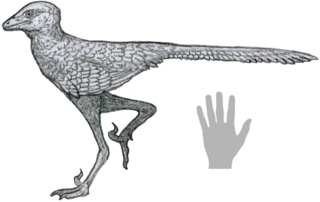
Liaoningvenator is a genus of troodontid theropod dinosaur from the Early Cretaceous of China. It contains a single species, L. curriei, named after paleontologist Phillip J. Currie in 2017 by Shen Cai-Zhi and colleagues from an articulated, nearly complete skeleton, one of the most complete troodontid specimens known. Shen and colleagues found indicative traits that placed Liaoningvenator within the Troodontidae. These traits included its numerous, small, and closely packed teeth, as well as the vertebrae towards the end of its tail having shallow grooves in place of neural spines on their top surfaces.




